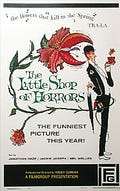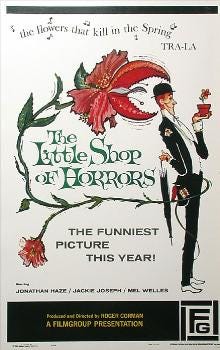The Little Shop of Horrors (1960) – Dualist
Happy Halloween, my Spooky Friends!
And welcome back for our fifth and final Review Roulette: Spooky Edition!
This week we’re going with a classic I didn’t know was a classic – Roger Corman’s The Little Shop of Horrors (1960). I will be the first to admit that while it fully makes sense that the 1986 musical film of the same name is a remake of a dawning-of-New-Hollywood film, I had never given it a second thought. If you are a fan of the musical starring Rick Moranis and a whole host of other greats or of the stage show it was adapted from, and if you were likewise unaware that Corman did the original, I invite you to seek it out. It’s 71 minutes long (you know how much I appreciate a film under 90 minutes) and I found it on Tubi in the UK (it’s also on Prime in the US, I believe). The Review Roulette wheel landed on Dualist for our approach this week and I want to add in a layer of my own on top of that: Environmentalist. Let’s climb right in.
Disclaimer: It’s a holiday (and also less than a week to the US election and exactly three weeks before my PhD thesis defence) so we’re going a bit lower key this week. Beware of cursing and stream of consciousness.
So, The Little Shop of Horrors is a little film about a little shop with ever increasing horrors. A florist shop clerk named Seymour (Jonathan Haze) acquires a plant and bargains his job on the plant’s prosperity with his boss, shop owner Gravis Mushnick (Mel Welles). Seymour quickly learns that the plant (whom he named Audrey Jr. after his colleague and crush Audrey (Jackie Joseph)) requires human blood to survive and thrive. Excellent premise, 10/10.
It’s a comedy, and though I haven’t seen the 80s remake in a long time, I will hazard to say that the Corman comedy in all it’s crazy chaos might be even better. Corman prizes some straight up kookiness and gives to us as a gift four excellent characters for seemingly no reason. Two are the detectives investigating disappearances around Skid Row, played by Wally Campo and Jack Warford. The detectives are easily the best part of the film in my opinion because they play it all so straight to an unnecessary degree of parodying 50s TV detectives like Dragnet. It’s comedic gold. The third character is a masochistic guy who gets his good off going to a sadistic dentist, played by none other than a very young Jack Nicholson (played by a young Steve Martin in the 80s).
The fourth character, and the one who provides the opposition for our dualist analysis, is Burson Fouch (Dick Miller). Fouch strolls into the little flower shop and requests carnations to eat. Obsessed. At first everyone is like “say it isn’t so” clutching their pearls as this guy just starts munchin’. There is active concern, and then it just evaporates and no one questions it again even though he’s just chowing down on petals and making comments about his wife making gardenias for dinner. The straightness with which he is played almost makes you question why we don’t eat flowers on the reg like this fuckin guy. BDE.
And that’s interesting, right? We see this guy eating flowers and second guess ourselves, meanwhile there’s a grotesque flower that subsists on human blood (presumably – Seymour never tries anything else like perhaps a different animal). And then Seymour just stumbles into three different murders. We are not meant to believe that he is a serial killer, largely because he is just so simple and gentle, we are to assume he wouldn’t hurt a fly. (Side bar: if there is a serial killer in this movie, my money is on Mrs. Shiva, the Skid Row funeral home director, who comes into the flower shop on the daily with a story about another dead family member or acquaintance like she’s Angela Lansbury.)
So, this is our dichotomy, right? We have a guy straight munching on flowers like a lovable psycho opposite a plant straight munching on people like a terrifying monster. And my question is was this guy eating flowers just a weird kooky character Corman added in for funsies, or are he and this whole film an elaborate condemnation of our anthropocentric idea of the world in which nature is subservient to man in all things? Probably the former, but let’s run with the latter.
There is so much death in this little 71-minute comedy. My husband remarked that “life is cheap in this film” after one of the numerous deaths Mrs. Shiva was getting her coin for, and I think that’s a really powerful statement if we consider our anthropocentrism.
Around the shop, Mushnick (who speaks broken English) has signs that read “we don’t letting you spend so much” and “cheap plants”. Repeatedly we are told how cheap these flowers are at the shop and Mushnick just gives them away for free sometimes despite being concerned about the financial wellbeing of his shop. Seymour even kills two gladiolas in a scene played as a gag. The plants are not even considered to be alive, apart from Audrey Jr. who can speak and is therefore anthropomorphised. No one questions the lives that are being ended, sold, and consumed when they are plants, but the film’s premise requires a societal understanding of that the ending and consuming of human lives is abhorrent (yes I agree with that, I am making a point though).
I think the film is questioning the values of both human and plant lives and the key to that is the repeated localising of Skid Row. We are told constantly that the little flower shop is on Skid Row. Skid Row is historically (and especially portrayed in media as) the home of vagabonds, vagrants, and the unhoused, people left behind by society and deemed unimportant, often written off by society as alcoholics or criminals. Mrs. Shiva announces numerous deaths of her acquaintances on Skid Row that never get an investigation or even concern, but the moment a railroad cop and a dentist go missing, the two detectives arrive to ask some questions.
When we see Fouch munching on flowers, it’s weird because it’s a societal oddity that someone would bite into a carnation, but it is then immediately normalised. When we see Shiva announcing deaths, there’s a moment of concern but it too is immediately normalised as just her character. I think Corman drew a throughline between the faceless deaths on Skid Row and the cheap plants being eaten by Fouch, labelling them both as inconsequential lives. Likewise, the anthropomorphized plant and the humans we see – even though they are morally or mentally harmful – are beings for whom we are meant to feel something. Corman is pointedly asking us which lives we value, and I think that deserves the follow up question of why?
It’s a silly little comedy, but I do think it offers us a fascinating and profound opportunity to question our own anthropocentrism. Why is it okay for a person to eat plants to survive but not for a plant to do the same? Why are we humans arbiters of what beings get to sustain life? Why is Mrs. Shiva allowed to vertically integrate her funeral home by committing the murders herself? It’s worth thinking about. I wonder if the 1980s version offers the same kind of environmentalist questions or a different twist on it in a post-EPA America.
Anyway, I do recommend watching this weird little film and seeing what you make of the chaotic kookiness Corman delivers so well. Whatever you are doing, I hope you have a wonderful Halloween, and to my American readers, stay strong and go vote if you haven’t already. I’ll see you next week for an Election Day special!
Because I’m Never Done When I Say I Am
Rampant Speculation
I’m just going to throw this out there not as analysis but as rampant speculation – I think Jack Nicholson made Audrey Jr. There is no real logic behind this but Seymour first says he got the seeds from a Japanese gardener, then we see a sign that says the plant is form the jungles of Africa, and then Seymour claims to have crossbred two plants to create her like a little horticulturist even though he’s a bit dumb and we see no other evidence that he has any ambition at all let alone to be a horticulturist. Plus, Jack Nicholson is on this poster for some reason? I think he did it. He made that plant because he’s a masochist and wanted it to eat him or something, I don’t know but he’s involved. (I know it’s probably just because he’s famous later and this is a later released poster but he did it.)
P.S. I didn’t even mention that Seymour sings Christmas carols while doing murder shit. That’s tea for another day.




